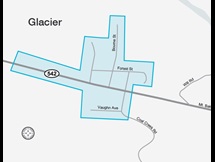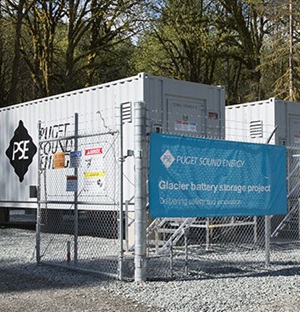Glacier demonstration project
Utility-side solutions for outage mitigation and balancing demand
In late 2015, PSE started construction on a 2-megawatt (MW), 4.4 megawatt-hour (MWh) lithium-ion battery system adjacent to the existing substation in the Whatcom County town of Glacier.
The project is funded in part by a $3.8 million Smart Grid grant from the Washington State Department of Commerce, in addition to a $7.4 million investment by PSE. The Glacier demonstration project is designed to perform three primary functions:
- Reduce system load during periods of high demand
- Balance energy supply and demand, helping to support greater integration
- Serve as a short-term backup power source to “island” a portion of the local Glacier circuit during outages
Islanding: an evolving technology
Islanding (sometimes called a “microgrid”) is a complex process that involves many working parts. But, for battery installations like the one in Glacier, it basically means creating a power source that can safely operate separately from the grid.
Utilities across the country are testing battery technology and islanding capabilities with varying degrees of success. Each community must tackle distinctive geographical and weather challenges, different energy requirements, unique infrastructure, etc. In other words, while battery technology offers a lot of exciting potential, it’s still a process determining the best applications to serve customers’ unique needs.
As for PSE’s Glacier installation, the town’s remote location and energy infrastructure make it a good setting for testing and evaluating many applications, including islanding. The town is serviced by a 55 kV radial transmission line that runs approximately 10 miles along a heavily-forested highway, making it challenging for crews to locate and repair electrical problems during storms. Battery storage systems, like the one in Glacier, have the potential to provide several hours of back-up power to the town core during storm outages, as well as other grid-enhancing functions throughout the year.
Project details
The battery was energized in 2016, and in January, 2017, achieved its first successful islanding attempt. Between January, 2018 and June, 2018, Pacific Northwest National Laboratory (PNNL) performed two use test cases. Since then, PSE has continued to test the battery’s capabilities under planned outage scenarios – working toward the goal of successfully responding to unplanned outages.
As of August, 2019, PSE has successfully powered Glacier’s town core through more than six planned outages. It should be noted that planned outages and testing procedures can pose inconveniences for residents, but they ultimately yield vital information for responding to unplanned events.
The Glacier battery’s first successful unplanned response occurred on Monday, February 4, 2019. On that day, the battery remotely responded to an outage and provided power for approximately 4 hours, until repairs were made to the transmission line.










